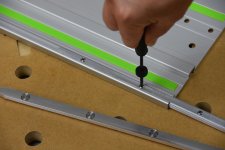- Joined
- Nov 21, 2015
- Messages
- 850
[member=67413]box185[/member] - you're quite right that a ball driver with a long enough blade or a flexible shaft driver could be made to work. Where we derailed with the wedge or other expansion device was the cost imposed by market level pricing for such a low volume item in woodworking.
it would be interesting to see a proforma itemized list of parts with production and tooling cost for every single line item, plus tooling amortization and see what selling price would have to result.
Ask what the individual cost of the mass produced "D" Wedgelock is.
Hans
it would be interesting to see a proforma itemized list of parts with production and tooling cost for every single line item, plus tooling amortization and see what selling price would have to result.
Ask what the individual cost of the mass produced "D" Wedgelock is.
Hans


